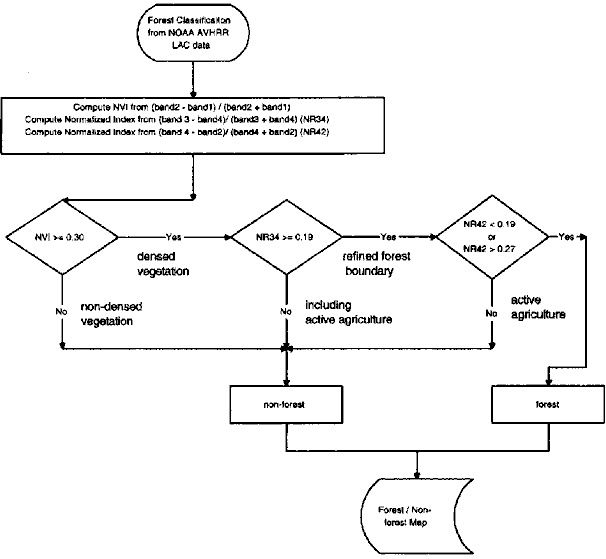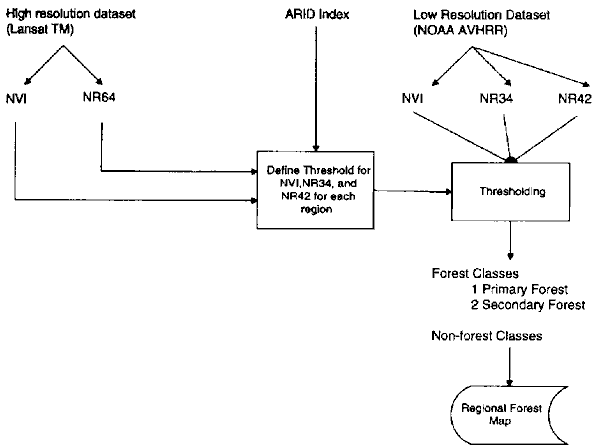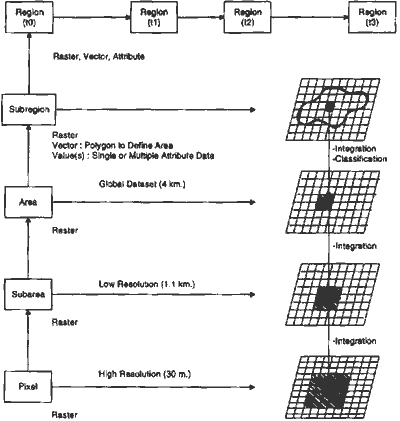| GISdevelopment.net ---> AARS ---> ACRS 1995 ---> Poster Session 2 |
Computer Assisted Monitoring
of Vegetation Using Multl-resolution Satellite and Geospatial Data
Mr. Surat Lertlum *, Prof.
Shunji Murai **
* Doctoral Student, Asian Institute of Technology
E-mail: surat@cs.ait.ac.th
** Professor, Asian Institute of Technology
E-mail: smj@cs.ait.ac.th
Abstract
* Doctoral Student, Asian Institute of Technology
E-mail: surat@cs.ait.ac.th
** Professor, Asian Institute of Technology
E-mail: smj@cs.ait.ac.th
The main purpose of this paper is to illustrate: the outline of a new vegetation monitor methodology, I especially tropical forest by using remote sensing and GIS.
The emphasis is on the usage of new technology in remote sensing and GIS to monitor, I analyze, and predict the forest resource at regional level. First, a multi-resolution forest classification is I proposed, by using low resolution remotely-sensed data (NOAA AVHRR LAC 1.1 km. resolution) as the main 1 source of data for vegetation monitoring, and using high 1 resolution remotely-sensed data (Landsat TM 30 m. resolution) as the ground correction data for each subregion. Next we illustrates the usage of objected- oriented data model to handle multi-resolution, multi- temporal integration problem.
1 Introduction
In this section, we introduce some general knowledge related to proposed multi-resolution tropical forest classification:
- Main Data Source (NOAA A VHRR) : The advantages of low resolution
satellite data (NOM A VHRR) data are :
- Wide area coverage
- More frequency of obtaining input data
The disadvantages of low-resolution satellite: - data (NOAA AVHRR) data are:
- Inaccurate classification of small area (less than 1.1 km2).
- Inaccurate classification of subregion that vegetation may have different reflect characteristics.
- Vegetation Classification:
In general, vegetation classification methods using remotely-sensed data are :- Using NDVI (Normalized Difference \ Vegetation Index)
- Unsupervised Classification
- -Supervised Classification c
- Spatial Information System:
The current requirements for spatial information system are:- Remote sensing stand point:
- Can handle multi-resolution data t
- Can handle multi-temporal data
- GIS stand point:
- Can handle both raster and vector data
- Can integrate raster and vector data
In this section, we introduce a new methodology for vegetation classification from low resolution satellite data (NOAA AVHRR LAC 1.1 km.) utilizing thermal bands.
From the trend study on tested data, the relationship between forest area, data from each band, and normalized difference indices from selected bands, the result shows that forest land can be classified with the combination of 3 parameters:
| 1 NDVI =
(band2-band1)/(band2+band1 ) 2 NR34 = (band3-band4)/(band3+band4) 3 NR42 = (band4-band2)/(band4+band2) |
These parameters involve data from 4 bands, which include thermal infrared band (band 4) of NOAA A VHRR. The proposed classification method utilizes the use of thermal band by using natural characteristic of forest area that the temperature of forest area should lower than the surrounding. (Lertlum and Murai, 1994) (Figure 1 Decision tree for forest classification)

Figure 1 Decision tree for forest classification
3 Vegetation classification from multi-resolution satellite data
Information derived from coarse spatial resolution sensors that have high temporal data acquisition rates (e.g. NOAA AVHRR) are required to accommodate the vast land area included in tropical surveys. Higher resolution sensors (MSS, TM, SPOT) are necessary tools to record the spectral and spatial detailed needed to link intensive ecological field of studied to the forest community and biome levels.
From previous section, a new methodology for vegetation classification from low resolution satellite data (NOAA A VHRR LAC 1.1 km.) utilizing thermal bands is introduced. In this section, we continue to apply similar methodology to high resolution satellite data (Landsat TM 30 m.).
For high resolution data (Landsat TM), the relationship between forest area and data from each band, normalized difference indices from selected bands shows that forest land can be classified with the combination of 2 parameters:
| 1 NDVI (NVI) (Normalized
Difference Vegetation Index) = (band4-band2)1(band4+band2) 2 NR64 (Normalized Difference Index between band 6 and band 4) = (band6-band4) /(band6+band4) |
Table 2 bleows list the characteristics of NVI and NR64 for each type of data:
| type of area | respond from NVI | respond from NR64 |
| primary forest | high | low |
| secondary forest | mid-range | mid-range |
| plantation/high tree | high | mid-range |
| rice field | low | low |
| grass land/rice field after harvest | low | high |
| water | low | low |
From the proposed forest classification methods for NOAA AVHRR and Landsat TM I we can integrated both of the classified results by using the result from Landsat TM classification to calibrate the result from NOAA AVHRR for each subregion as mentioned previously. The integration can be performed by the method of defining more precise threshold for NOAA AVHRR data using classified forest sample from Landsat TM for each subregion, that will be devided by ARID index (Figure 2 Forest classification framework)

Figure 2 Multi-resolution forest classification framework
4 Object-oriented data model for multi-resolution I multi-temporal remote sensing and
GIS data
The object-oriented approach, a relatively new method in computing, is an attempt to improve modeling of the real world. Whereas previous modeling approaches were more record oriented, essentially too close to the computers, this new paradigm is a framework for generating models closer to real world features. The ideal would seem to be to provide an isomorphy, that is a direct correspondence, between real world entities and their computer representation. (LAURINI and THOMPSON, 1992)
In this section, an object-oriented data model for multi-resolution and multi-temporal remote sensing and GIS data sets is introduced. This data model can be used to solve the problem that is critical to relational spatial information system in handling complex data sets.
This data model is illustrated by classes and methods that can be used to integrate multiple data sets.
Proposed object-oriented data model for multi- resolution/multi-temporal remote sensing and GIS data is descripted by the following definition of classes and methods (Lertlum and Murai, 1995) :
Classes
- Point Class: to represent coordinate (x, y)for referencing purpose.
- Line Class: to represent pair of coordinate (x, y) that I can be used to define line object.
- Polygon Class: to represent set of line object that can ~ be used to define area by user.
- Pixel Class: to represent smallest high resolution "data object such as data from Landsat TM.
- Subarea Class: to represent smallest standard resolution data object (NOAA A VHRR LAC 1.1 km).
- Area Class: to represent smallest global data object : such as NOAA AVHRR GAC or global data set such as , Moisture Index, ARID index.
- Subregion Class: to represent country as a data object which include data in both raster and vector formats.
- Region Class: to represent multi-temporal region as a data object which also inherits properties from Subregion class.
The following are general type of methods for classes defined above:
- Value reclassification from real numbers, that is, interval or ratio scales, to ordered categories.
- Value substitutions, such as averages, particular values like a maximum,
- Value creation through combinations of values for different attributes via arithmetic operations, perhaps using advance statistical techniques.
- Value creation through Boolean logic Combinations via trigonometry or interpolation.
- Value assignment, substituting values from one variable for another.
- Those which involve a spatial property as well as non- spatial attributes.
- Integration method between different resolution pixel (classes) of the same coverage.
- Classification: is a type of categorization of data object using spectral, spatial and temporal information.
- Change detection: is the extraction of change between multi-date data object.
- Extraction of indices: is the computation of a newly defined index, for example, the vegetation index from satellite data.
- Identification of specific features is the identification, for example, of disaster, lineament, archeological and other features.
In order to monitor forest area in such a wide area as Southeast Asia Peninsula, high resolution dataset cannot easily be used for such a task because of the high volume of the data. Low resolution dataset such as data from NOAA A VHRR is a solution to such a task. A forest classification technique by using band 1 , 2, 3, and 4 of NOAA AVHRR including thermal bands is proposed in this study for more precise tropical forest classification. In addition, the same methodology is applied to high resolution dataset (Landsat TM), the result of the classification with high resolution dataset can differentiate classes of forest.
Then we illustrates the use of objected-oriented data model to handle the integration problem of multi- resolution, multi-temporal data sets by defining an objected-oriented data model that can handle multi- resolution, multi-temporal remote sensing and GIS data sets. This data model consists of classes and methods that can be used to integrate multiple data sets. The next step on this research study is to implement the spatial information system from the methodology and data model proposed in this paper.

Figure 3 Object-Oriented Framework for Multi-resolution / Multi- Temporal Satellite Remote Sensing and GIS Data Sets
References
- LAURINI, R., and THOMPSON, D.; Fundamentals of Spatial Information Systems, Academic Press, 1992, pp 644-646
- LERTLUM, S., and MURAl, S.; Forest Mapping with NOAA A VHRR Data: Case Study: Effect of Thermal and for Refining Forest Mapping, Proceedings of the 15th Asian Conference on Remote Sensing, Nov 17- 23,1994, Bangalore, India, pp E51-E56
- LERTLUM, S., and MURAl, S.; Object-Oriented Data Model for Multi-Resolution / Multi- Temporal Remote Sensing and GIS Data Sets, Proceedings of the 2nd AM/FM Asia, Aug 17 -23, 1995, Bangkok, Thailand, ppE51-E56
- LlLLESAND, M., T, and KIEFER, W., R.; Remote Sensing and Image Interpretation, John Wiley and Sons, Republic of Singapore, 1987., pp 15-17, 566-567.
- MILNE, P., MIL TON, S., and SMITH, J., L. (1993); Geographical Object-oriented Databases-a case study, Int. J. Geographical Information Systems,- 1993, Vol.7, No.1., pp39-55.
- MURAl, S., (editor), Applications of Remote Sensing in Asia and Oceania-Environment Change Monitoring, Asian Association on Remote Sensing, 1991
- MURAl, S., (editor), Remote Sensing Note, Japa:1 Association on Remote Sensing, 1993
- MURAl, S., Special Course on Advanced Re.'T1ote Sensing/GIS Technologies: Data Fusion of Multi-sensor Data, AIT, Bangkok, Thailand, 1994.
- PEUQUET, D., J. and DUAN, N.An Event-based Spatiotemporal Data Model (EST DM) for Temporal analysis of Geographical Data, I Int. J. Geographical Information Systems. L 1994, Vol.9, No.1 pp7-24.